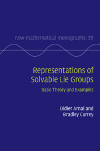- About MAA
- Membership
- MAA Publications
- Periodicals
- Blogs
- MAA Book Series
- MAA Press (an imprint of the AMS)
- MAA Notes
- MAA Reviews
- Mathematical Communication
- Information for Libraries
- Author Resources
- Advertise with MAA
- Meetings
- Competitions
- Programs
- Communities
- MAA Sections
- SIGMAA
- MAA Connect
- Students
- MAA Awards
- Awards Booklets
- Writing Awards
- Teaching Awards
- Service Awards
- Research Awards
- Lecture Awards
- Putnam Competition Individual and Team Winners
- D. E. Shaw Group AMC 8 Awards & Certificates
- Maryam Mirzakhani AMC 10 A Awards & Certificates
- Two Sigma AMC 10 B Awards & Certificates
- Jane Street AMC 12 A Awards & Certificates
- Akamai AMC 12 B Awards & Certificates
- High School Teachers
- News
You are here
Representations of Solvable Lie Groups

Publisher:
Cambridge University Press
Publication Date:
2020
Number of Pages:
478
Format:
Hardcover
Series:
New Mathematical Monographs
Price:
155.00
ISBN:
9781108428095
Category:
Monograph
[Reviewed by , on ]
Mark Hunacek
12/6/2020
The classical theory of harmonic analysis, dealing with sums and integrals of sine and cosine terms, can be generalized in several ways. One way, as Audrey Terras notes in her book Fourier Analysis on Finite Groups and Applications, is to study representations of groups, where the matrix entries of irreducible unitary representations act as a substitute for these sine and cosine terms. Terras’s book studies finite groups, leading to discrete harmonic analysis. Representations of infinite groups, particularly those satisfying certain additional properties, are also a fruitful source of inquiry. And that brings us to the book now under review, the goal of which, according to the preface, is “to develop abstract harmonic analysis in the context of a very concrete presentation of solvable Lie algebras and Lie groups and their representations.”
This agenda involves, as the quoted statement above should make clear, a considerable amount of sophisticated mathematics, and I would estimate the intended audience of this text to be people ranging from second or third year graduate students to professional mathematicians. A year of graduate-level algebra is certainly an essential prerequisite for this book, as is enough background in analysis and topology to know what words like “topological group” and “manifold” mean. (Both of these quoted terms, for example, are used on page 28 with no prior definitions offered.) Later in the book, measure theory is employed.
Nevertheless, the authors have (technically, at least) stopped short of requiring a background in Lie theory: the book begins with a chapter discussing, first, solvable Lie algebras and then Lie groups. This chapter starts at the beginning with the definition of a Lie algebra but gets rather quickly (representations and weight spaces are introduced on page 5, for example) to some fairly sophisticated results, including a proof of Ado’s theorem, at least for real solvable Lie algebras. The proof of this theorem is often omitted in introductory texts in Lie theory, such as the classic book by Humphreys. Thus, although prior exposure to Lie theory is perhaps not logically necessary, it would, given the speed and sophistication of the presentation, seem to be of substantial value in understanding what follows.
Additional sophisticated background material is discussed in the third chapter, which provides an exposition of unitary representations and Mackey theory. This is done in the context of separable, locally compact groups and uses such tools as Haar measure.
There are four other chapters, discussing various advanced techniques and methods for studying representations on solvable Lie groups. The authors describe this in the literature as a “distillation of a massive body of research dating from the middle twentieth century.” One technique, introduced in chapter 2 and used throughout the text, is a “stratification method” for studying orbits.
For several reasons, I don’t see this book getting used much as an actual text for a graduate course. For one thing, the subject matter of this text is not often covered in standard courses; for another, there are no exercises. The publisher itself appears to be marketing this book as a research monograph rather than a text: the back-cover description of the book describes it as “an invaluable reference guide for graduate students as well as researchers.”
As reference books go, however, the authors have made a real effort to make this book accessible. There is, as previously noted, the included background material on Lie theory, and there are also quite a lot of examples provided. Aspiring researchers in this area will likely find these features helpful, both aspiring and current researchers should also appreciate the wealth of material found here, as well as the extensive (five page, 92 entries) bibliography.
Mark Hunacek (mhunacek@iastate.edu) teaches mathematics at Iowa State University.
See the publisher's website.
- Log in to post comments




